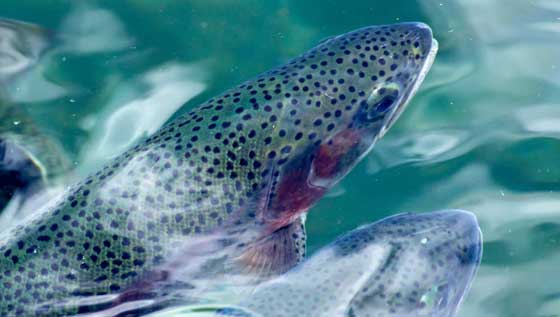Rainbow Trout Feeding Preferences

Rainbow Trout Facts
These are not fussy eaters. They’ll eat or go after whatever baitfish are located in their distribution along with worms, leeches and crustaceans.
For Rainbow Trout, the simplest baits work very well, no need to get complex here.
However, this doesn’t mean that they’ll go after anything all of the time. The best way to drive this point home is that person we all know that will eat absolutely everything. Once in a while this person will only go after hamburgers or ice cream and ignore all other foods available.
- Tip: Always have a few baits with you when fishing. As Rainbow Trout often school together, they all seem to have the same food preference, forsaking all but the top food preference for that day.
Rainbows prefer prey as they’re just starting to enter their growth stage and begin to increase in large numbers. In the Great Lakes this includes smelt and alewife in the spring.
When Rainbows are feeding, they feed until they’re full and then will not eat for some time until they’ve had time to digest their food and are hungry again. This is referred to as ‘a non-feeding cycle’ among pro anglers.
Once they are ready to start feeding again, their preference is usually another food source unless their lake or river habitat has little variety.
Best flies for Rainbow Trout
- In June, caddis flies, damsels flies and dragon flies are very popular.
- In March and April smelt and alewife are very popular
Daily Food Preferences
Food preferences for Rainbow Trout usually changes from one day to another. Their food preferences also changes from hour to hour. They can be feeding off popular bait fish in the morning and change in the middle of the afternoon.
Understanding their habitat is important. Knowing the reason for the change can help you choose a better bait. If insect larvae are hatching in the morning, then expect these baits and lures to be very successful in the afternoon.
The change in preference comes from the availability of food sources. Know the hatching patterns of flies, fish and schooling patterns.
- If you’re not familiar with the lake or river that you’re fishing, or if you have no way of gaining local information, find out what the lake has to offer and bring along the top 5 baits available. Cast for about 10 minutes and if not successful, try a different bait.
These fish have a varied diet and there is some guessing. The more knowledge you have of a given lake, the better your success will be at guessing their top foods.
- A good idea is to take a log book with you and document which baits work on which days along with the date, time, temperature and conditions.
Table Fare Quality Indicators
What does Rainbow Trout taste like? They have a tender and mild flavor, more subtle than that of the Atlantic Salmon that has a more pronounced flavor.
The flavor difference from farmed versus wild Rainbow Trout is that wild Rainbow Trout caught in lakes have an earthy taste. This is preferred over farmed Rainbow Trout that have a nutty flavor, which is least desired. The best taste comes from wild trout that feed on shrimp and other sea creatures. The color indicates where they spend their time.
How to tell Steelhead vs Rainbow Trout flesh?
If the Rainbow Trout have a dark red or orange meat, then they are seagoing Steelhead Trout or a farmed rainbow trout given a supplemental diet with a high astaxanthin content. The resulting pink flesh is marketed under monikers such as Ruby Red or Carolina Red.
Farmed Rainbow and Steelhead Trout
Rainbow Trout and Steelhead are farmed throughout the world. Commercial production didn’t start until 1950, but has grown dramatically every decade. In 2007, 604,695 were farmed in the United States, Canada, Chile, Europe and China. China has become the newest country to exploit this opportunity. The largest producer currently is Chile and more and more countries are exploiting this opportunity as a food source. This is putting less pressure on wild stocks, although other issues are created due to the amount of waste being dumped into the local habit which has its own issues.



